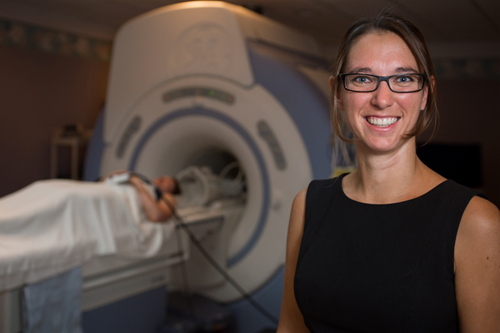 Phillips’s talk, “New Frontiers in Neurohumanities: An fMRI Study of Literary Attention and Jane Austen,” discusses new work in cognitive approaches to literature, the neuroscience of narrative and the history of mind. Its focus is on a unique cross-disciplinary experiment that teamed scholars in the humanities, radiology, and neuroscience to explore the evolving neural networks involved in attention and reading in the brain. The study used tools from neuroscience, such as functional magnetic resonance imaging (fMRI) and eye tracking, to explore the cognitive dynamics involved in reading a literary work with different levels of attention. Using fMRI, her team analyzed complex changes in brain activity as doctoral students in literature read a chapter of Mansfield Park with two styles of attention: close reading (or, literary analysis) and pleasure reading. The study’s surprising early results suggest that such re-focusing in reading is far from subtle. Scans demonstrate dramatic and unexpected increases in blood flow to regions of the brain far beyond those responsible for “executive functions,” suggesting that how we read may be as important as what we read. Linking this fMRI study of attention and Phillips’s research on the literary history of distraction, the work suggests that research crossing the supposedly “unbridgeable divide” between humanities and sciences is in fact central to advancing our understanding of mind and brain. Phillips also proposes that understanding attention’s history is crucial, arguing that a series of key debates over focus that continue to shape modern neuroscientific studies have roots that can be traced back to the Enlightenment. Finally, and most importantly, she suggests that advancing narrative neuroscience will involve a still-closer alliance among literary scholars, creative writers, artists, and scientists, working to provide a real-time view of the brain as we engage with complex works of literature, music, or art.
Phillips’s talk, “New Frontiers in Neurohumanities: An fMRI Study of Literary Attention and Jane Austen,” discusses new work in cognitive approaches to literature, the neuroscience of narrative and the history of mind. Its focus is on a unique cross-disciplinary experiment that teamed scholars in the humanities, radiology, and neuroscience to explore the evolving neural networks involved in attention and reading in the brain. The study used tools from neuroscience, such as functional magnetic resonance imaging (fMRI) and eye tracking, to explore the cognitive dynamics involved in reading a literary work with different levels of attention. Using fMRI, her team analyzed complex changes in brain activity as doctoral students in literature read a chapter of Mansfield Park with two styles of attention: close reading (or, literary analysis) and pleasure reading. The study’s surprising early results suggest that such re-focusing in reading is far from subtle. Scans demonstrate dramatic and unexpected increases in blood flow to regions of the brain far beyond those responsible for “executive functions,” suggesting that how we read may be as important as what we read. Linking this fMRI study of attention and Phillips’s research on the literary history of distraction, the work suggests that research crossing the supposedly “unbridgeable divide” between humanities and sciences is in fact central to advancing our understanding of mind and brain. Phillips also proposes that understanding attention’s history is crucial, arguing that a series of key debates over focus that continue to shape modern neuroscientific studies have roots that can be traced back to the Enlightenment. Finally, and most importantly, she suggests that advancing narrative neuroscience will involve a still-closer alliance among literary scholars, creative writers, artists, and scientists, working to provide a real-time view of the brain as we engage with complex works of literature, music, or art.
Conference Sessions on Wednesday, Feb.26
SHOW ME: Full Schedule ONLY SHOW ME: Wednesday Feb.26 | Thursday Feb.27 | Friday Feb.28
Special Guest Lecture | New Frontiers in Neurohumanities:
An fMRI Study of Literary Attention and Jane Austen
Wednesday, February 26, 2014 - 6:00pm
Presented in collaboration with the English Department Convergences program

